

 All-American Girls Professional Baseball League ®
All-American Girls Professional Baseball League ®By the fall of 1942, many minor league teams disbanded due to the war. Young men, 18 years of age and over, were being drafted into the armed services. The fear that this pattern would continue and that Major League Baseball Parks across the country were in danger of collapse is what prompted Philip K. Wrigley, the chewing-gum mogul who had inherited the Chicago Cubs' Major League Baseball franchise from his father, to search for a possible solution to this dilemma. Wrigley asked Ken Sells, assistant to the Chicago Cubs' General Manager to head a committee to come up with ideas. The committee recommended a girls' softball league be established to be prepared to go into Major League parks should attendance fall due to franchises losing too many quality players to attract crowds.
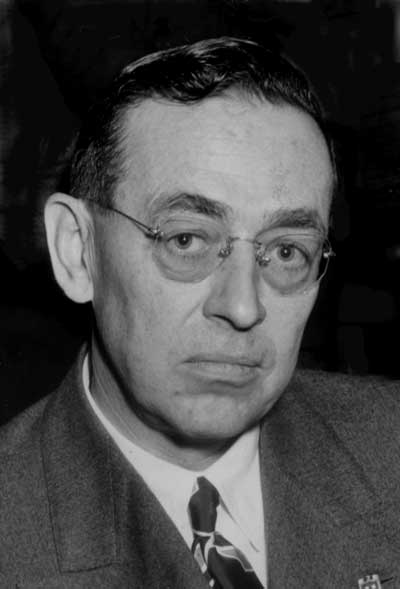
Philip Wrigley
With the dedication of a group of Midwestern businessmen and the financial support of Mr.Wrigley, the All-American Girls Softball League emerged in the spring of 1943. The League was formed as a non-profit organization. A board of trustees was formed which included Philip K. Wrigley; Branch Rickey, Brooklyn Dodgers President and General Manager; Paul V. Harper, Chicago attorney and trustee for the University of Chicago and Chicago Cubs attorney; and Ken Sells, who was named President of the League. Midway in the first season of play, the board of trustees changed the League's name to All-American Girls Base Ball League (AAGBBL) to make it distinctive from the existing softball leagues and because the rules of play were those of Major League Baseball. However, the retention of shorter infield distances and underhand pitching caused some controversy in the media about "Baseball" in the League name. Thus, at the end of the 1943 season, the official League name was again changed to the more descriptive All-American Girls Professional Ball League (AAGPBL). This title was retained until the end of the 1945 season when All-American Girls Base Ball League (AAGBBL) was again adopted and retained through 1950. It was during this time period that overhand pitching and smaller ball sizes were adopted. When independent team owners purchased the League at the end of the 1950 season, the official League name was changed to the American Girls Baseball League (AGBL), but popularly it continued to be identified as the All-American League or the All-American Girls Base Ball League (AAGBBL). Through the organization of the Players' Association in1987, and through their efforts to gain recognition by the National Baseball Hall of Fame in 1988, the league has now come to be recognized as what it was in actuality: the All-American Girls Professional Baseball League (AAGPBL).
The first major issue facing the trustees was to establish what game of ball was going to be played by the women and to define the rules for this new brand of ball. Chicago Cubs' scout, Jack Sheehan, former player and part-time scout for the Cubs, and Vern Hernlund, supervisor of recreation for the Chicago Parks Department, worked with Ken Sells to write the new set of rules for the League. Since the only organized ball for women in the country was softball, they created a game which included both softball and baseball. There were semi-pro women's softball teams of quality women players in Chicago and many other urban centers throughout the U.S. and Canada. The skill of these teams provided a logical basis for the use of a 12-inch softball and underhand pitching. They wanted, however, to liven up the game. In an effort to increase hitting and spotlight base running and fielding, they extended the length of softball's base paths and pitching distance. They also incorporated men's base running rules by allowing runners to lead off and steal bases. Softball at the time included 10 players. This new game would parallel men's baseball in number of players (9) and types of equipment.
The second major issue facing the trustees was to find the talented women playing softball or baseball across the country. Jim Hamilton, 30-year veteran player, manager, owner, and Chicago Cubs' scout, was hired as the Head of Procurement to locate and sign women from all over the United States and Canada. In Canada, the driving force was Johnny Gottselig, former defenseman for the Chicago Blackhawks National Hockey Team in the 1920's and 1930's.
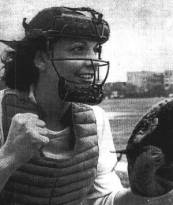
Mary "Bonnie" Baker
© Life Magazine June 1945
Gottselig, a native of Regina, Sask., was managing the Blackhawks' Kansas City farm team in 1942. He had many contacts among sporting figures in the provinces, one of whom was a Regina-based hockey scout named Hub Bishop. Bishop was responsible for signing Mary "Bonnie" Baker, All-Star catcher for the South Bend Blue Sox, and other highly skilled players from the many popular softball leagues which existed in Canada. Johnny Gottselig became the first manager of the Racine Belles in 1943, and managed his team to the first recognized World Championship of the newly organized AAGPBL. Wrigley already had an established recruitment network in place from his ownership of the Cubs and had sports connections throughout North America. Jim Hamilton, with several assistants, was responsible for procuring players from California to New York. Many players were screened from the Chicago Softball League and other existing softball leagues throughout the country. Bill Allington, former minor league player and then a coach in a southern California softball league, was also an active scout for the All-American League. Allington became the manager for the Rockford Peaches in the summer of 1944 and remained as a manager in the league throughout the league's existence.
By sending out scouts and setting up try-outs in dozens of major cities, Wrigley attracted hundreds of women from all over America and Canada who were eager to play in this new professional league. Of these, only 75 were invited to the final try-outs in Chicago where 60 were chosen to become the first women to ever play professional baseball.
Wrigley originally envisioned that Major League baseball parks could profit from having the women play on the dates the men's teams were scheduled to be on the road. He calculated this would maximize the use of the parks which were now only utilized 50% of the time. He approached other Major League owners, but the idea was not well received. Four non-Major League cities were selected that were in close proximity to the League headquarters in Chicago and close to each other. The cities chosen were Racine and Kenosha Wisconsin, Rockford, Illinois, and South Bend, Indiana. Arthur Meyerhoff, Wrigley's advertising agent, was given the responsibility of coordinating operations with city officials and civic leaders in the communities. A projected budget was developed, and Wrigley agreed to fund half the cost of operating each team and all over-budget expenses. The host city directors agreed to pay the other half of projected operating costs.
Teams consisted of fifteen players, a manager (coach), a business manager, and a woman chaperone. It was believed that by acquiring notable men sports figures as managers for the girls' teams, there would be greater curiosity and interest by the public. The first managers selected were Johnny Gottselig; Bert Niehoff, former Major League player and minor league manager; Josh Billings, former Major League player; and Eddie Stumpf, former Milwaukee Brewers catcher.
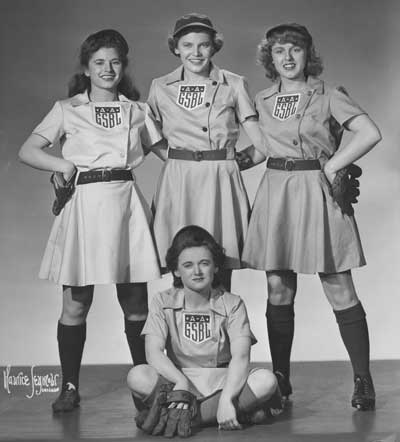
First players signed in 1943
Standing, L-R: Clara Schillace, Ann Harnett and Edie Perlick. Seated: Shirley Jameson. (From Northern Indiana Center for History Collection.)
Spring training was set for May 17, 1943, at Wrigley Field in Chicago. All the players stayed at the Belmont Hotel close to Wrigley Field. The final selection process began on the first day. League officials systematically scrutinized each player. They were tested on playing their field position, throwing, catching, running, sliding and hitting. At the end of the day, no one wanted to answer the phone for fear of being told they would have to pack and go home. Those who survived the cut were signed to professional league contracts which stated they were not to have any other employment during the baseball season. Salaries were high for many of these young players, some as young as 15. In many cases they were making more than their parents who had skilled occupations. Salaries ranged from $45 to $85 a week plus. Those who were signed not only had to be highly skilled players, they also had to comply with high moral standards and rules of conduct imposed by the League.
In addition, femininity was a high priority. Wrigley contracted with Helena Rubenstein's Beauty Salon to meet with the players at spring training. After their daily practices, the women were required to attend Rubenstein's evening charm school classes. The proper etiquette for every situation was taught, and every aspect of personal hygiene, mannerisms and dress code was presented to all the players. In an effort to make each player as physically attractive as possible, each player received a beauty kit and instructions on how to use it. (See Charm School and Rules of Conduct for details).
Mrs. Wrigley, Wrigley's Art Designer, Otis Shepard, and Ann Harnett collaborated to design special uniforms for the League. Ann Harnett, Chicago softball star and the first girl to sign a contract with the league, became a model for the new uniforms. The one-piece short-skirted flared tunic was fashioned after the figure skating, field hockey, and tennis costumes of the period. Satin shorts, knee-high baseball socks and baseball hat completed the uniform. Each city had a different colored uniform and its own symbolic patch decorated the front of the uniform.
The League Office assigned managers, players and chaperones to teams. It was their intent to balance the talent on each city's team to make league play highly competitive. Players were often traded in mid-season to maintain that balance. League play officially began on May 30, 1943 with South Bend playing in Rockford and Kenosha playing in Racine. A total of 108 games were played in the regular season, which ran from mid-May to the first of September. The team to win the most games during the regular season was declared the pennant winner. The top teams then competed in a series of play-off games to determine the League Champion. At the end of the 1943 season, the Kenosha Comets played a 5-game series against the Racine Belles for the Championship. Racine won and became the first World Champions of the All-American Girls Base Ball League.
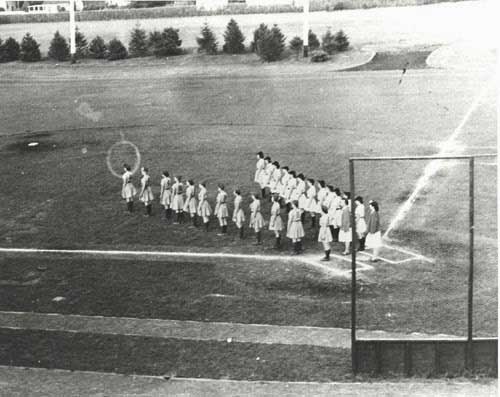
Players Lined up in Their Wartime, Pre-Game "V" for Victory Formation. (Northern Indiana Center for History Collection)
Assessment of the first year of play was encouraging. The teams were well received by fans in the four sponsoring cities. Attendance was tracked at 176,612 fans for the 1943 season. National League officials, the press and baseball fans across the country were amazed at how well the women played ball and by the enthusiasm and support the teams received in their host cities. Several factors contributed to this success. Most of the nation was involved in one way or another in the war effort. Women, who were formerly homemakers, left their homes to support the war by taking jobs in factories that were converted into making munitions and other military machinery. This change in the traditional occupation of women made the environment much friendlier for accepting women as professional ball players. Another factor was the limits the war placed on the American people. Some foods, luxury items, tires and gasoline were rationed. People were forced to spend their leisure time close to home.
Going to the ballpark was a popular form of entertainment. Wrigley also managed to capitalize on the patriotic mood of the country. America's young men were off fighting for our country, dreaming of the girls they left behind. Playing on the Theme of "All-American Girl," he promoted the image that the players were symbols of "the girl next door" in spikes. At the beginning of each game, the two teams formed a "V" for Victory from home plate down the first and third baselines followed by the playing of the Star Spangled Banner. The players played an even greater part in displaying patriotism by playing exhibition games to support the Red Cross and the armed forces, as well as visiting wounded veterans at Army Hospitals. Talent for the league was abundant, and it was soon evident that the women's high caliber of play was going to be the main drawing card for the fans.
May 14 to May 25, 1944, was the time set for the second spring training camp for the AAGPBL. It was held in Peru, Illinois, and one hundred twenty girls, six managers and all league personnel were housed either at the Peru Hotel or at the St. Francis Hotel in Peru's twin city, LaSalle. There was access to three diamonds for the camp, swimming pools and a gym. Ruth Tiffany School was contracted to run the nightly charm school. The emphasis was to make "bright stars" of each player by integrating a healthy mind and a healthy body. The arts of walking, sitting, speaking, selecting clothes, applying make-up, and social skills were again part of the program. The importance of being feminine and projecting the image of "The All-American Girl Next Door," along with outstanding athletic ability, continued to be on the top of Wrigley's list of priorities.
As a result of the success of the League in its first year, civic groups in each of the four cities agreed to finance their own franchises. This gave Wrigley the opportunity to try his dream of placing the girls' teams in Major League parks. He, Paul Harper, and Branch Rickey agreed to finance two additional teams to play in American Association ball parks in Minneapolis and Milwaukee. League scheduling for the 1944 season was structured to play in the minor league stadiums of these two cities during the time periods the men were on road trips. Former Major League Hall of Famer, Max Carey, became the manager for the newly formed Milwaukee Chicks, and Bubber Jonnard, was chosen to manage the Minneapolis Millerettes.
The two new teams were excited to be playing in American Association League parks. However, when compared to teams playing in smaller parks in the medium-sized cities of Racine, Kenosha, Rockford, and South Bend, the differences were obvious. Media coverage was a big difference. The smaller cities received extensive media support. Like the men's teams, all the games were reported with articles and box scores and sometimes the papers even ran photographs. In the large cities, the games were often not even mentioned or received negative publicity. The fans sat very close to the field and the dugouts and became friendly with the players as individuals in the smaller cities. In the large stadiums, the distances between the fans and the player did not give the women this advantage. Even the size of the field itself was a handicap to the women who could not hit the ball over the fences for homeruns. This sharp contrast between the men playing faster regulation baseball on certain nights, and the women basically playing a modified softball fast pitch on others, did not favor the women. Even though the larger cities offered a greater population base, there was also a much greater diversity of entertainment opportunities from which people could choose to spend their leisure time. Attempts to add pre-game entertainment of all kinds, including novel symphony performances, failed to increase attendance. Another factor in the failure of the Minneapolis and Milwaukee teams may have been Wrigley's decision to "go it alone" in these cities or his inability to recruit local guarantors to subsidize teams there. In any case, he didn't have the nucleus of leading businessmen in Minneapolis and Milwaukee to support and promote their AAGPBL teams as had been accomplished in the smaller cities.
Early in the 1944 season, it became evident that the war would not force major league baseball to disband, and Wrigley lost interest in the girls' league. Despite poor attendance in the two American Association parks, overall AAGPBL attendance increased. After the season, Wrigley sold the League to his Chicago advertising executive, Arthur Meyerhoff. It was under Meyerhoff that expansion and publicity of the League reached its peak. On Nov. 15, 1944, Meyerhoff met with representatives from the four original cities and re-organized the League so that each franchise would be governed through a League Board of Directors with representatives from each franchise. Each club now had a voice in the adoption of rules and regulations and the direction of the sport. All assets were turned over to the new directors and Wrigley was no longer involved with the league. Ken Sells resigned as league president and Max Carey was named the new president.
Meyerhoff undertook a rigorous advertising campaign to promote the League in 1945. Everything was going well with the war and for the League. Patriotic fans were ensuring the League had a future. Families were turning out in large numbers at all the ballparks. The Milwaukee Chicks were picked up by Grand Rapids, Michigan, and the Minneapolis Millerettes went to Fort Wayne, Indiana. Meyerhoff continued to project the image he and Wrigley had envisioned for these women. They were now involved deeply in displaying their abilities on the playing field. The emphasis changed and Charm School was discontinued. Meyerhoff arranged for the girls to play exhibition games at 13 army camps and veteran hospitals during the last five days of spring training. The players went into the hospitals and spoke to the wounded soldiers before and after the games. Players in the League eagerly supported the War effort. Several of the players had husbands and brothers overseas and many had relatives in the service. This war effort brought a lot of positive publicity national press to the League. The All-Americans celebrated the end of World War II on August 14, 1945, at the ballpark. The war ended but the All-American Girls Professional Ball League was in full swing. By the end of the season, attendance reached 450,313.
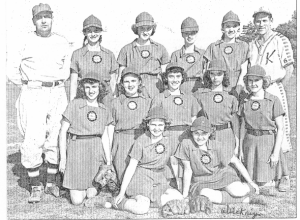
A Team of Junior Racine Belles
Life was great. The All-American host cities organized Junior Leagues for young girls 14 years and older. The teams traveled to exotic locations for spring training: Pascagoula, Mississippi in 1946; Havana, Cuba in 1947; and Opalocka, Florida in 1949. The rules were modified each year to lengthen infield distances and approve first side-arm pitching (1946) and overhand pitching (1948). The League acquired franchises for two more teams in Peoria, Illinois and Muskegon, Michigan, and a four-team minor league was established in Chicago as the Chicago Girls Baseball League (CGBL). Ambitious post-season tours to Cuba and South America were organized as part of a plan to create an International League of Girls Baseball. The Springfield (Illinois) Sallies and Chicago Colleens were added to the League's roster in 1948 but lost their franchises by the end of that season. For the next two years the Colleens and Sallies became rookie training teams that played exhibition games and recruited new talent as they toured through the South and East. Highlights of these tours included contests in Washington, D.C.'s Griffith Park and New York's Yankee Stadium.
In the first three years after World War II, teams often attracted between two and three thousand fans to a single game. One League highlight occurred when an estimated 10,000 people saw a 1946 Fourth of July double-header in South Bend, Indiana. The AAGPBL peaked in attendance during the 1948 season, when ten teams attracted 910,000 paid fans. However, attendance declined in the following years. One of the reasons for decreasing attendance and a resulting decrease in revenues was the decentralization of the League. At the end of the 1950 season, team directors voted to purchase the AAGBBL from Arthur Meyerhoff and operate their teams independently. Max Carey resigned as League President and was replaced by his assistant, Fred Leo. With no centralized control of publicity, promotion, player procurement, and equalization of player talent, the League began to break down. Individual team owners' financial circumstances declined and hindered their ability to operate on deficit spending resulting from declining attendance. The shrinking of the local fan base resulted in part from the rise of other forms of recreation and entertainment and the advent of televised major league games in the early 1950s. In addition, by this time the All-American game was purely baseball and talented women baseball players were not easy to find. Talented softball players needed training and experience for success in the All-American baseball game with its longer infield distances, smaller ball, and overhand pitching. As revenues fell, individual teams were no longer able to support rookie training teams like the Colleens and Sallies, and funds were limited to advertise nationally as a way of recruiting scattered baseball talent. By 1952, only six teams remained in the league after Kenosha and Peoria were disbanded. In 1953, the Battle Creek team was relocated to Muskegon, and by the end of the season, it too, folded. The 1954 season ended with only five teams remaining: Fort Wayne, South Bend, Grand Rapids, Kalamazoo, and Rockford.
The All-American Girls Professional Baseball League gave over 600 women athletes the opportunity to play professional baseball and to play it at a level never before attained. The League operated from 1943 to 1954 and represents one of the most unique aspects of our nation's baseball history.